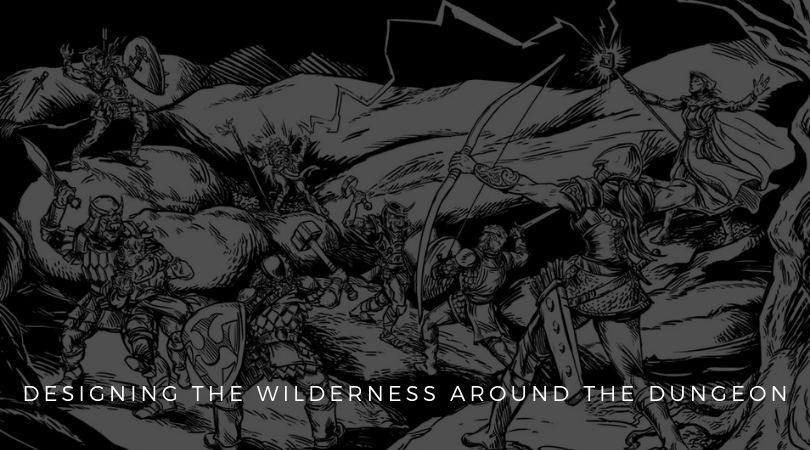Designing the Wilderness Around the Dungeon

Well designed dungeons need many things: a purpose for existing, an evocative name, an ecology that (vaguely) works, interesting features, a decent range of dungeon dressing and more. However, what they also need is a decent swath of wilderness in which to lurk.
Consider these examples:
- The castle in I7 Ravenloft is surrounded by wilderness rich in minor adventuring sites.
- The ruined monastery and the dungeons below in B5 Horror on the Hill (an overlooked classic) can only be reached after a gruelling trek through the monster-infested wilderness.

- The Tower of Heavens (from UK5 When a Star Falls which is another overlooked classic) stands at the centre of a great swath of hills and mountains.
- Sakatha’s tomb hosts the climax of I2 Tomb of the Lizard King, one of my all-time favourite modules. It squats amid a noisome swamp, and just reaching the place is an achievement.
- The Vault of the Drow from the adventure of the same name would have felt somewhat lesser without the vast network of surrounding caves and caverns.
Would any of them have been as good adventures if the wilderness portions were removed? Hell, no.
That said, some modules are undeniably marvellous even without a well detailed surrounding wilderness (but would have been much better with one added). For example:
- The Moathouse from T1 The Village of Hommlet is perhaps one of the greatest—if not the greatest—low-level dungeon crawl ever written. (The village is fantastic as well). Sure, it’s not fancy, and it’s not sophisticated, but it’s brilliant nonetheless. How much better could it have been, though, if Gary had fleshed out the surrounding countryside?
- The Caves of Chaos from B2 The Keep on the Borderland is a classic adventure site. Millions of heroic adventurers have fought the foul creatures dwelling therein. Sure, the area around the caves does receive some design attention in the module, but it could have been so much more.
What’s So Great About the Wilderness?
Adding an area of surrounding wilderness to a dungeon does several things:
Diversity
A swath of wilderness creates different challenges. Rangers, druids and the like shine in the wilderness but sometimes struggle to bring all their abilities to play in a dungeon. Providing an area of wilderness gives those characters somewhere to be in the spotlight. It also enables you to use different kinds of monsters—monsters that probably wouldn’t make sense in the dungeon—and different types of challenges.
Separation
A swath of wilderness creates separation (or perhaps a buffer) from civilisation. Often this gives the storylines of the dungeon more realism; for example, if the orc tribe lives next to the town, why hasn’t war come to the region? Similarly, if a ruined temple must remain unexplored (and unlooted) until the characters arrive, it’s much better located far away from prying eyes.
Sanctuary
A swath of wilderness creates the possibility of sanctuary from the horrors lurking in the dungeon. Even the harshest wilderness has pockets of safety. Canny characters can retreat to these areas—hidden caves, fortified homesteads of brave settlers and so on—to rest and recuperate without having to withdraw all the way back to town. Sometimes, the characters may even get significant help at these sanctuaries.
Story
A swath of wilderness creates somewhere to tell a story. If the dungeon is stuffed full of orcs, undead or whatever, a surrounding wilderness gives you somewhere to reveal more of the story. If bandits lair in the ruined castle, the party might find the nearby roads mysteriously empty of traffic or merchants only travelling under heavy guard. They may even find slain merchants, abandoned wagons and so on. Such details build flavour and may even give the party clues about what lies ahead.
Transition
A swath of wilderness creates a transition zone. Often jumping immediately from a tavern’s comfy common room into a deadly adventure can be jarring and disconcerting. A wilderness area provides somewhere the characters can “warm-up” for the adventure.
The Wilderlands of the Shadowed Keep
All this has got me thinking about a module I wrote several years ago: The Shadowed Keep on the Borderlands. I designed it as a homage to the Moathouse in T1 The Village of Hommlet. However, I neglected to design a surrounding wilderness area. When I updated the module to celebrate Raging Swan Press's 11th anniversary, I corrected this mistake and included a swath of wilderness around the keep.

The keep now sits at the centre of several other minor sites of interest which the characters can or cannot explore as they choose. I think the module is much better for this inclusion.
The Final Word
Not every dungeon needs a wilderness area. Some dungeons are set in and under towns or cities. I am not saying every dungeon needs a wilderness area. I am saying, however, that many dungeons could benefit greatly from such an addition.

Member discussion